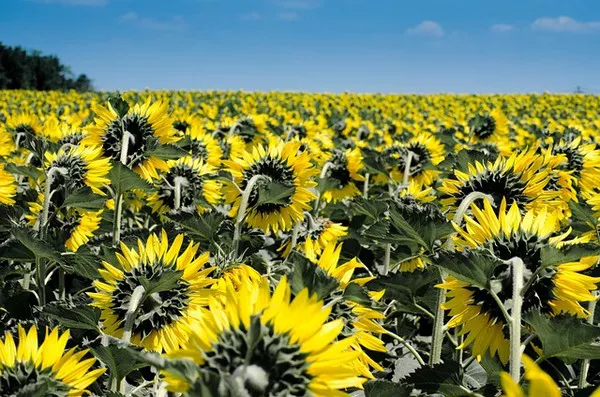Sunflowers, with their vibrant golden petals and imposing stature, have become synonymous with warmth and positivity. These iconic flowers have a fascinating history that traces back to the Americas, and their journey across continents has contributed to their widespread popularity. In this article, we will delve into the origins of sunflowers, exploring their natural habitat, cultural significance, and their transformation into a global symbol of beauty and resilience.
The Native Roots in the Americas
The sunflower (Helianthus annuus) is native to North America, primarily originating from the central and western regions of the continent. Indigenous peoples, particularly Native American tribes, played a crucial role in the cultivation and utilization of sunflowers long before European explorers arrived on the scene.
Historical evidence suggests that sunflowers were cultivated by Native Americans as early as 3000 BCE. Tribes such as the Aztecs and Incas revered the sunflower for its multifaceted uses. Beyond its aesthetic appeal, the sunflower provided a valuable food source, with the seeds serving as a nutritious staple in their diets.
Cultural Significance in Native American Societies
In Native American societies, the sunflower held spiritual and cultural significance. Many tribes considered the sunflower a symbol of resilience, adorning themselves and their surroundings with its bright blooms during ceremonies and celebrations. The flower’s ability to follow the sun’s path across the sky was seen as a representation of steadfastness and connection to nature.
Furthermore, Native American tribes extracted oil from sunflower seeds, using it for culinary purposes and medicinal applications. The versatile plant became deeply integrated into their daily lives, showcasing the resourcefulness and ingenuity of these indigenous communities.
The European Encounter and Global Dissemination
The arrival of European explorers in the Americas marked a pivotal moment in the sunflower’s history. Spanish explorers in the 16th century encountered sunflowers in present-day North and Central America and recognized their potential. The seeds, in particular, captured the interest of Europeans who saw them as a valuable food source.
As a result, sunflower seeds were transported to Europe, where they quickly gained popularity. The plant adapted well to various climates, leading to its successful cultivation in different parts of the continent. By the 18th century, sunflowers had become a common sight in European gardens.
Russian Adoption and Sunflower Agriculture
While sunflowers found a place in European horticulture, their journey did not stop there. Russia emerged as a key player in the cultivation and development of sunflowers. In the 19th century, Russian farmers began cultivating sunflowers on a larger scale, recognizing their economic potential.
Russian agricultural innovations, such as the development of high-oil-content varieties, contributed significantly to the global sunflower industry. The oil extracted from sunflower seeds gained prominence as a healthy cooking oil, and sunflower cultivation spread rapidly across Russia, Ukraine, and other Eastern European countries.
The Modern Global Presence
Today, sunflowers are cultivated on a massive scale across the globe, with major producers including Russia, Ukraine, Argentina, and the United States. Their adaptability to various climates and soils has contributed to their widespread cultivation, making them a staple crop in many agricultural landscapes.
Sunflowers are not only valued for their seeds and oil but also for their ornamental beauty. The iconic blooms have become a popular choice in gardens and floral arrangements worldwide. The symbolism attached to sunflowers, representing positivity, warmth, and resilience, has transcended cultural boundaries, making them a universal favorite.
See Also: How To Preserve Sunflowers Forever?
Economic Importance and Agricultural Innovation
The economic significance of sunflowers cannot be overstated. The cultivation of sunflower crops plays a vital role in global agriculture and economies. Sunflower oil, rich in monounsaturated fats and low in saturated fats, has become a healthy alternative in cooking, contributing to the growing demand for this versatile oil.
Agricultural innovation continues to shape the sunflower industry, with ongoing efforts to develop high-yielding varieties and improve cultivation practices. The sunflower’s adaptability to different climates makes it a valuable crop for regions facing diverse environmental challenges.
Beyond the agricultural sector, sunflowers have also found applications in the biofuel industry. Researchers are exploring the potential of sunflower biomass as a renewable energy source, further expanding the plant’s role in sustainable practices.
Conclusion
The journey of sunflowers from their native roots in the Americas to their global presence is a testament to the interconnectedness of cultures and the adaptability of nature. From being revered by Native American tribes to becoming a symbol of economic prosperity and positivity worldwide, sunflowers have come a long way.
Their story is one of resilience, adaptation, and the enduring beauty that transcends borders. Whether adorning gardens, contributing to healthy diets through oil production, or playing a role in sustainable agriculture, sunflowers continue to capture hearts and minds around the world. As we appreciate the golden blooms that follow the sun, we celebrate not just a flower but a living legacy that has flourished across continents and throughout centuries.


